Major road and railway bridges
This table presents the structures with spans greater than 100 meters (non-exhaustive list).
This list of bridges in Hungary lists bridges of particular historical, scenic, architectural or engineering interest. Road and railway bridges, viaducts, aqueducts and footbridges are included.
This table presents the structures with spans greater than 100 meters (non-exhaustive list).
{{cite web}}: CS1 maint: unfit URL (link){{cite web}}: CS1 maint: unfit URL (link){{cite web}}: CS1 maint: unfit URL (link){{cite web}}: CS1 maint: unfit URL (link){{cite web}}: CS1 maint: unfit URL (link){{cite web}}: CS1 maint: unfit URL (link){{cite web}}: CS1 maint: unfit URL (link){{cite book}}: |website= ignored (help)CS1 maint: multiple names: authors list (link){{cite book}}: |website= ignored (help)CS1 maint: location missing publisher (link) CS1 maint: multiple names: authors list (link)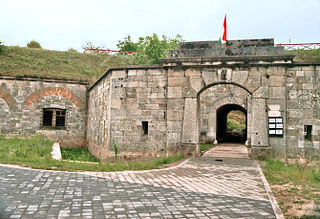
Komárom is a city in Hungary on the south bank of the Danube in Komárom-Esztergom County. Komárom fortress played an important role in the Hungarian Revolution of 1848 and many contemporary English sources refer to it as the Fortress of Comorn. On the south bank of the Danube, Komárom was formerly a separate village called Újszőny. On the northern bank of the Danube Komárom and Újszőny were connected with an iron bridge in 1892 and the two towns were united under the name city of Komárom in 1896. On 4th June 1920, the Treaty of Trianon split the city in two because the borders of Czechoslovakia were determined by the river Danube. This division separated the historical Komárom county of the Kingdom of Hungary and the city of Komárom. The bigger northern part of the city was attached to Czechoslovakia, renamed Komárno, its created a sizable Hungarian minority in present-day Slovakia. The southern part of the city, lying south of the Danube, remained in Hungary. On 2 November 1938 by the First Vienna Award, the northern part of the city was returned to Hungary and the divided Komárom reunified. At the end of World War II the city was again divided between Hungary and Czechoslovakia, Komárno is in today's Slovakia on the northern bank of the Danube.

Dunaújváros is an industrial city in Fejér County, Central Hungary. It is a city with county rights. Situated 70 kilometres south of Budapest on the Danube, the city is best known for its steelworks, which is the largest in the country. It was built in the 1950s on the site of the former village of Dunapentele and was originally named Sztálinváros, before acquiring its current name in 1961.

Magyar Rádió was Hungary's publicly funded radio broadcasting organisation until 2015. It was also the country's official international broadcasting station.

György (Móric) Klapka was a Hungarian general. He was one of the most important Hungarian generals of the Hungarian War of Independence of 1848–1849, politician, member of the Hungarian Parliament, and deputy War Minister.

Csepel, officially known as the 21st District of Budapest is a district and a neighbourhood in Budapest, Hungary. Csepel officially became part of Budapest on 1 January 1950.

Elisabeth Bridge is the third newest bridge of Budapest, Hungary, connecting Buda and Pest across the River Danube. The bridge is situated at the narrowest part of the Danube in the Budapest area, spanning only 290 m. It is named after Elisabeth of Bavaria, a popular queen and empress of Austria-Hungary, who was assassinated in 1898. Today, her large bronze statue sits by the bridge's Buda side connection in the middle of a small garden.
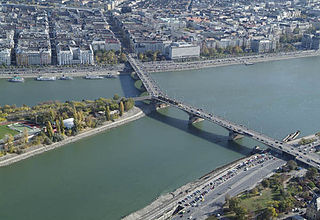
Margaret Bridge or Margit híd is a three-way bridge in Budapest, Hungary, connecting Buda and Pest across the Danube and linking Margaret Island to the banks. It is the second-northernmost and second-oldest public bridge in Budapest.
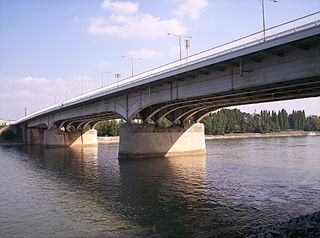
Árpád Bridge or Árpád híd is a bridge in Budapest, Hungary, connecting northern Buda (Óbuda) and Pest across the Danube.
The bridges of Budapest, Hungary, crossing the River Danube from north to south are as follows:

The Megyeri Bridge, previously known as the Northern M0 Danube bridge, is a cable-stayed bridge that spans the River Danube between Buda and Pest, respectively the west and east sides of Budapest, the capital of Hungary. It is an important section of the M0 ringroad around Budapest.
Budapest is the capital of Hungary. Below is a list of public place names of Budapest that refer to famous people, cities or historic events. Generality of Budapest's public place names relate to the Hungarian national history. In Budapest there are about 8,600 named public place.
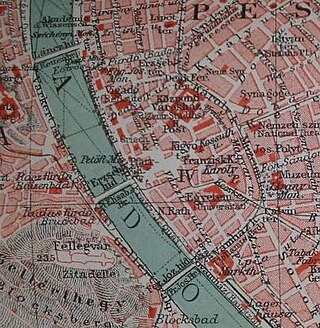
The Danube Promenade is located on the Pest side of Budapest, Hungary. The promenade itself lies on the left bank of the Danube, extending from the Széchenyi Chain Bridge to the Erzsébet Bridge.
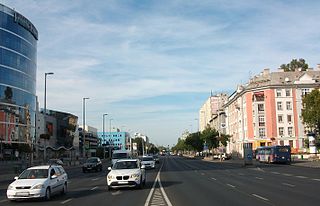
Váci út is one of the widest and busiest avenues in Budapest, Hungary. It is about 12 kilometers (7.5 mi) long and has four to eight traffic lanes.
The Santa Claus Cup is an annual international figure skating competition which is generally held in late November or early December in Budapest, Hungary. It is organized by the Hungarian National Skating Federation. Medals may be awarded in men's singles, women’s singles, and ice dance at the senior, junior, and novice levels.

The First battle of Komárom was one of the most important battles of the Hungarian War of Independence, fought on 26 April 1849, between the Hungarian and the Austrian Imperial main armies, which some consider ended as a Hungarian victory, while others say that actually it was undecided. This battle was part of the Hungarian Spring Campaign. After the revolutionary army attacked and broke the Austrian siege of the fortress, the Imperials, having received reinforcements which made them numerically very superior to their enemies, successfully counterattacked, but after stabilising their situation, they retreated towards Győr, leaving the trenches and much of their siege artillery in Hungarian hands. By this battle the Hungarian revolutionary army relieved the fortress of Komárom from a very long imperial siege, and forced the enemy to retreat to the westernmost margin of the Kingdom of Hungary. After this battle, following a long debate among the Hungarian military and political leaders about whether to continue their advance towards Vienna, the Habsburg capital, or towards the Hungarian capital, Buda, whose fortress was still held by the Austrians, the second option was chosen.

Clark Ádám is a crane vessel, specifically a floating sheerleg, built in 1980 in Budapest, Hungary, by the Hungarian Shipyards and Crane Factory Angyalföld Division. It originally had a lifting capacity of 120 metric tons, gradually raised to 200 tons by 2006, making it one of the largest in lifting capacity on Central European rivers. It is mainly used for building bridges, but is also commissioned to assist salvage operations, as well as to launch hydrofoils. It has rescued several ships; in 2019 it raised the sunken Hableány from the Danube at Budapest. The vessel is named after Scottish engineer Adam Clark (1811–1866).

Huba was a Hungarian tribal leader in the late 9th century. He was – according to the author of the early 13th-century Gesta Hungarorum, Anonymus – one of the seven chieftains (princes) of the conquering Hungarians. This credibility is uncertain, he may have been a person living later in the 10th century. He ruled the southern part of the Little Hungarian Plain, but just like with the other chieftains, there is not known which tribe he was chief of.